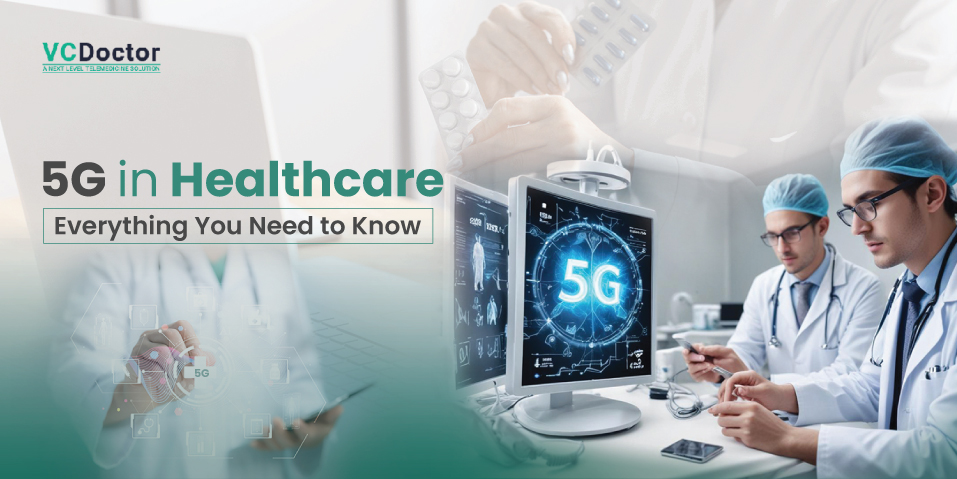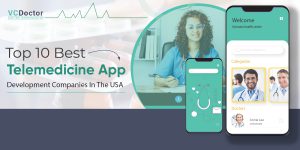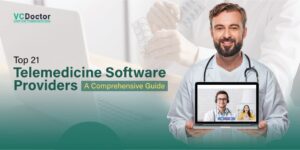5G in Healthcare: Everything You Need to Know in 2024
The healthcare industry has experienced countless innovations in the last decade. It helps healthcare providers and specialists deliver quality health services. One such innovation that stood out in the field of healthcare is 5G in Healthcare. Through telehealth technology, quality services can be delivered online through video consultations, which eliminates the need to travel.
This is made possible by the 5G technology that promotes fast and reliable solutions. It is a new-generation wireless technology that attracts reliability, connectivity and unparalleled speed. Through its high-speed data transmission, healthcare services are delivered timely, resulting in improved patient care. If you are eager to know about 5G in Healthcare, we have got you covered. This article is a complete guide on 5G on telehealth software. Here we go!
Table of Contents
- What Is 5G?
- How 5G is Changing Telemedicine?
- Role of 5G in Transforming Healthcare Services
- Benefits for Patients and Providers
- Implementation Challenges in 5G in Healthcare
- How Does VCDoctor Help with Telehealth Solutions?
- Conclusion
- FAQs
What Is 5G?
5G technology, also known as the fifth generation technology, is the latest mobile network standard which provides greater speed and efficiency than the 4g technology. Known for its 100 times faster speed than 4g and increased capacity, this network can easily handle multiple devices together. This technology seamlessly supports the growing need for data-intensive apps, including virtual reality, streaming and the Internet of Things. The improved reliability and performance of the 5G network drive advancements in different sectors. These include healthcare, automotive, and smart cities. Through an efficient network, it offers exceptional user experience and revolutionizes communication.
How 5G is Changing Telemedicine?
5G plays a significant role in revamping telemedicine app development as it improves the quality of sleep and the reliability of healthcare services delivered remotely. This results in better patient checkups and improved outcomes. Here are some of the top ways 5G Healthcare is changing telemedicine:
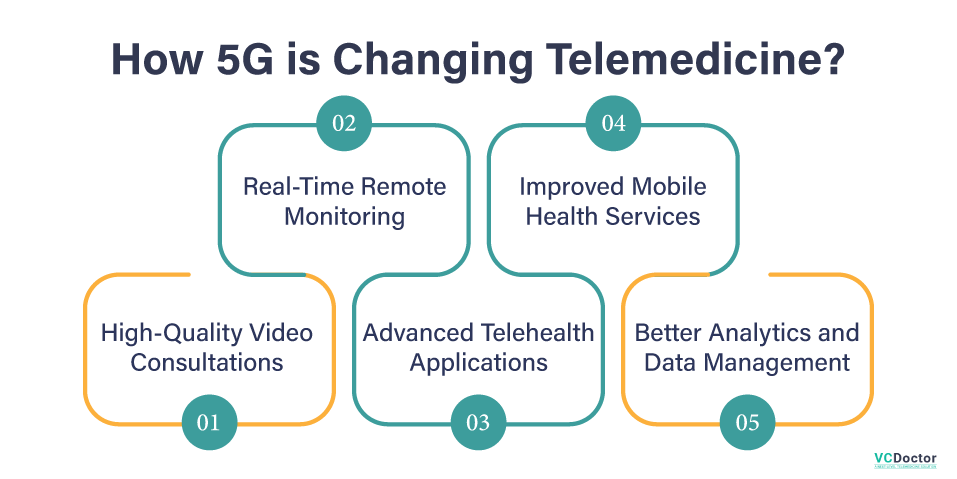
1. High-Quality Video Consultations
Unlike most networks, 5G Healthcare promotes easy and quick video calling, which results in a seamless video consultation in Telemedicine 5G. Thanks to this advancement, medical professionals can now do comprehensive exams, make precise diagnoses, and administer efficient therapies from a distance. Healthcare is more accessible when patients in underserved or rural areas may get specialized care without having to travel.
2. Real-Time Remote Monitoring
5G enables real-time remote patient monitoring via wearable technology and health sensors thanks to its reduced latency. These software offer access to healthcare information such as:
- Blood pressure
- Glucose levels
- Heart rate
This enables them to take urgent action as needed. This ongoing observation lowers hospital readmission rates, avoids complications, and aids in the better management of chronic illnesses.
3. Advanced Telehealth Applications
5G makes advanced telehealth 5G applications possible, including virtual reality (VR) training for medical professionals and remote robotic surgery. Robotic systems controlled by a 5G network enable surgeons to perform procedures from remote places with little latency and accurate control. Medical workers can easily access VR training courses through seamless streaming, which offers immersive, interactive learning opportunities that enhance abilities and expertise.
4. Improved Mobile Health Services
By enabling a greater number of linked devices and apps, 5G improves mobile health services. In rural or disaster-affected locations, mobile health units outfitted with 5G technology can offer on-the-spot diagnostic, imaging, and laboratory services. Even in difficult settings, this skill guarantees that patients receive prompt 5G medical attention.
5. Better Analytics and Data Management
5G in Healthcare networks’ enhanced capacity and dependability make it possible to handle massive amounts of medical data with efficiency. Data analytics tools are used to assess patient data and customize treatment plans. Further, 5G telemedicine is used to improve patient care and make better decisions. Further, resources are allocated carefully in the healthcare system.
Role of 5G in Transforming Healthcare Services
5G technology is successfully transforming healthcare services by promising efficient patient care. Here are some popular ways 5G in Healthcare is transforming the healthcare services:
1. Enhanced Telemedicine
5G’s low-latency, high-speed connectivity greatly enhances telemedicine solution for patients. It enables smooth, high-definition video consultations, guaranteeing transparent, immediate contact between medical professionals and patients. Accurate diagnosis and successful treatments are made easier by this innovation, which largely benefits patients who may not access specialized care as they live in remote areas.
2. Remote Surgery and Robotics
Robotic surgery is made possible by 5G networks’ ultra-reliable low latency. Surgeons are able to execute difficult surgeries with great accuracy and little delay from a distance. In emergency cases where time and skill are crucial, this capability may potentially save lives by increasing access to specialist surgical knowledge. Additionally, it encourages the creation and 5G applications in healthcare of cutting-edge surgical robots, which improve the accuracy and results of surgical procedures.
3. Real-Time Remote Monitoring
Thanks to wearable technology and health sensors connected to 5G networks, patients are monitored continuously and in real time. This competence is essential for preventative treatment and chronic illness management. Doctors get access to data from these devices instantly. It allows for individualized treatment regimens and prompt actions. Additionally, it reduces hospital stay time, which improves patient convenience and reduces healthcare expenses.
4. Improved Emergency Response
5G Healthcare technology improves emergency response services by enabling quick and dependable communication between medical institutions and first responders. Emergency rooms can receive real-time video feeds, high-quality photos, and vital signs from the scene. This enables medical professionals to get ready and give important instructions before the patient arrives. In urgent circumstances, this prompt and well-coordinated reaction can greatly enhance patient outcomes.
5. Advanced Healthcare Analytics
5g-connected devices generate vast amounts of data that are collected and analyzed to improve healthcare delivery. Further, the data is processed through artificial intelligence to find patterns in health and customize therapies. Better patient outcomes result from this data-driven strategy, which also optimizes resource allocation and improves decision-making.
Benefits for Patients and Providers
Here are the top benefits of 5G in healthcare for patients and healthcare providers:
1. Improved Access to Care
5G technology promotes quality medical care and telemedicine services, allowing patients in remote areas to access a telemedicine platform for doctors without traveling for hours. Quick and quality video consultations promise accurate and clear communication, which makes it easier for patients to get treatment timely. If you are a healthcare expert, you may provide quality services to people beyond borders. This makes quality healthcare services accessible.
2. Enhanced Real-Time Monitoring
Vital signs and health issues can be continuously monitored with wearable technology and health sensors connected via 5G. The efficient management of chronic illnesses is facilitated by this real-time data transfer, which also guarantees prompt treatments upon the detection of anomalies. Continuous monitoring gives medical staff members access to the most recent patient data, empowering them to quickly and intelligently modify treatment regimens.
3. Faster Emergency Response
5G makes it possible for first responders and medical facilities to communicate quickly and reliably in emergency scenarios. When patients arrive at the 5G hospital, they are given the right care right away, thanks to real-time data and video transmission from the incident. Medical teams can increase the likelihood of successful interventions and better patient outcomes by preparing ahead of time for incoming patients.
4. Advanced Medical procedures
Advanced medical technology, such as remote robotic surgery, can be used with 5G assistance. No matter where they live, patients may receive top-notch surgical treatment, which lessens the need for travel and increases access to specialist operations. Surgeons are able to execute intricate treatments with accuracy and speed, increasing their capabilities and lowering the dangers involved in doing conventional surgery.
5. Efficient Data Management and Analytics
Improved health outcomes are possible through proactive healthcare management and individualized treatment plans. Big data can be processed rapidly by AI and advanced analytics. This enables medical practitioners to see patterns, anticipate epidemics, and allocate resources optimally. This increases the overall efficiency of healthcare delivery.
That’s Why is 5g important in healthcare industry!
Implementation Challenges in 5G in Healthcare
Some major challenges of 5G in healthcare are:
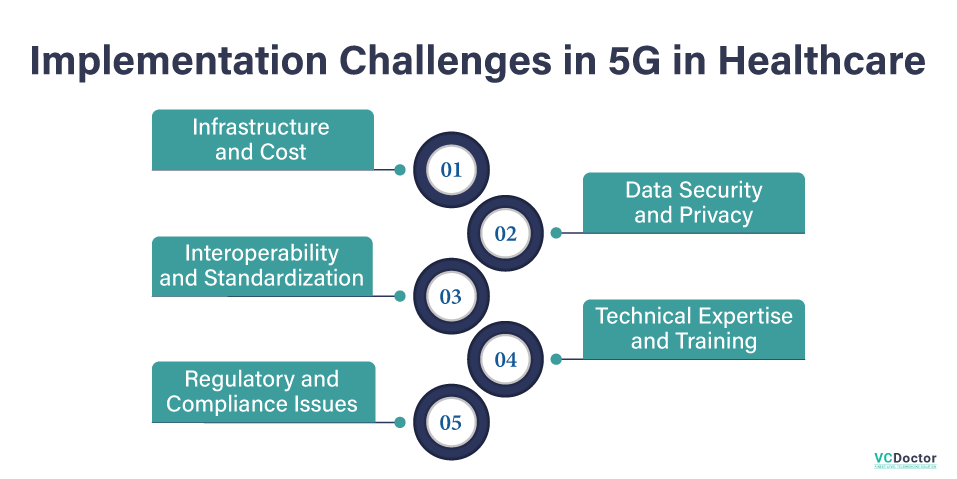
1. Infrastructure and Cost
A significant amount of money must be invested in new infrastructure to deploy 5G networks, which includes installing numerous tiny cells and modernizing current equipment. Healthcare facilities may find it difficult to cover the significant expenditures of this change, particularly in poor or rural locations.
2. Data Security and Privacy
Chances of cyberattacks and data breaches exist due to the proliferation of connected devices and the transmission of private patient information. You must protect the patient’s data for privacy and security purposes. Strong cybersecurity controls, such as multi-factor authentication and frequent security audits safeguards patient data and preserve system confidence.
3. Interoperability and Standardization
Interoperability problems arise because healthcare systems and devices made by different vendors frequently employ multiple communication protocols and standards. This may make it more difficult for 5G technology to be seamlessly integrated across many telehealth services platform. The creation and acceptance of global standards and protocols for medical equipment and systems can help to guarantee seamless 5G technology integration and promote interoperability.
4. Technical Expertise and Training
Healthcare personnel might not have the particular technical knowledge and skills needed to administer and maintain the new systems, and the deployment of 5G technology calls for them. Employing technical specialists and offering extensive training programs can assist healthcare facilities in developing the skills needed to successfully deploy and 5G uses technology.
5. Regulatory and Compliance Issues
The deployment of 5G technology must abide by different laws and rules pertaining to patient safety and telecommunications standards due to the strict restrictions governing the healthcare industry. Adoption processes can go more smoothly if regulatory organizations are closely consulted to make sure 5G deployments comply with all applicable laws and that the required certifications are obtained.
How Does VCDoctor Help with Telehealth Solutions?
VCDoctor is a renowned provider of HIPAA Compliant telehealth software for startups that enables doctors to provide tailored solutions to patients without the time and location constraints. Professionals here keep a patient-centric approach where appointment bookings are made online. If you are looking for telehealth solutions, you may contact experts at VCDoctor!
Looking for a feature-rich telemedicine solution?
Conclusion
The seamless blend between technology and the healthcare sector is reshaping the medical services offered and delivered. Since 5G Healthcare technology is integrating deeply into our daily lives, it significantly improves patient care and offers high-quality health services. As this technology continues to improve and adapt widely, it will make necessary advancements in the healthcare sector.
FAQs
1. What are the major benefits of 5G technology for patients?
Some major benefits include improved patient outcomes, increased access to care and cost efficiency.
2. What will the use of 5G in healthcare be in the future?
Healthcare professionals may securely and accurately monitor patients thanks to 5G technology, which also makes it possible to perform remote vital sign monitoring, real-time video consultations, and even remote surgery.
3. Mention a list of technical and infrastructural challenges
Common technical and infrastructural challenges include:
- Infrastructure development
- Cybersecurity concerns
- Integration with all existing systems
- Cost implications

